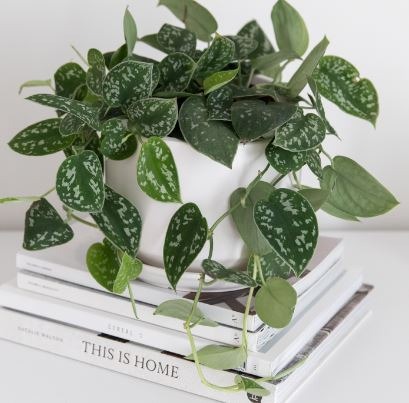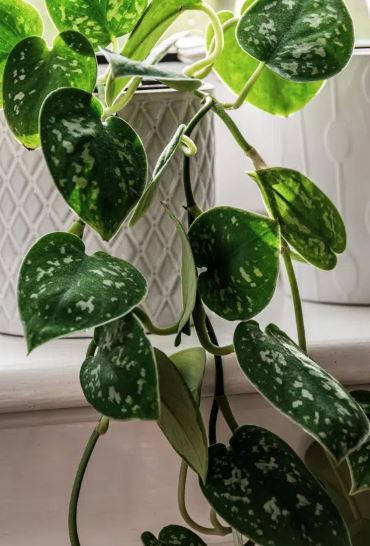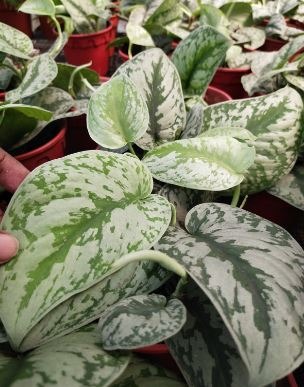Story of Day :

Satin pothos (Scindapsus clipart), like its botanical cousin (Epipremnum aureum), is one of the easiest houseplants to grow.
Both are members of the Arum Genus.
They are cold-tolerant tropical vines.
That’s why Satin Pothos are often grown indoors. What sets Satin Pothos apart from other Pothos is the variety of foliage.
The heart-shaped leaves have silvery gray spots, which give them an almost glossy appearance and add to the plant’s visual appeal.
The intensity of the spots depends on the cultivar. Satin pothos is vines that will stick around them — be it posts, trusses, other plants, walls, or furniture.
The way plants attach to surfaces is through their aerial roots. Sometimes it does it independently; sometimes, it needs a little help, such as with a mini-covered hook.
Instead of allowing them to propagate, you can also plant satin pothos in hanging planters where the leaves will hang out.
Contents
Specification of Satin Pothos
- Science Fiction Botanical Names Common Names satin pothos, silk pothos, silver pothos, silver philodendron.
- Adult size has a length of 1.21-4,3 m.
- Sun exposure: Indirect light indoors.
- Soil Type: Mixed potting soil
- PH: 6.1 to 6.5
- Bloom time: summer
- Flower color: White spot green
- USDA Zones: 10-12, United States Territory
- native to Southeast Asia
- Toxicity to humans and animals
Satin Pothos (Scindapsus Pictus) Care

Satin pothos is an ornamental plant that is easy to care for.
In addition to maintaining regular watering and fertilizing, an extra step you can take to improve its appearance is to remove any damaged or dead leaves and trim them when the vines get too long and become too thin.
Pruning the plant will encourage the growth of new leaves and make them fuller.
Tree pruning is best done in the spring when the growing season begins.
If your Satin Pothos has become dusty, you can wash the leaves with water.
Do not use oil to polish it, as it can clog the cells and affect the breathability of the leaves.
Light
Satin Pothos (Scindapsus Pictus) needs bright but indirect light. When exposed to full direct sunlight, the leaves lose color and become scorched.
If you place the plant near a window with direct sunlight, you will need curtains to avoid direct sunlight.
Soil
Use a commercial indoor potting mix that already contains nutrients and ensures good drainage through peat moss, pine bark, and perlite or vermiculite.
Scindapsus Pictus grows poorly in wet, waterlogged soil.
Watering
When watering the pit with satin, it is essential to avoid over-watering, which will manifest with the yellowing of the leaves and wilting of the plant.
Water only when the top two inches of soil feel dry to the touch — stick your finger in the ground to check.
Flush slowly and deeply with room temperature water until you see water seeping out of the drainage holes.
Temperature and humidity
Satin pothos is a tropical plant that needs warmth and moisture.
The ideal growing temperature is 18-29 degrees Celsius; the plant will cool down and die at lower temperatures.
In dry air, the tips of the leaves may turn brown. Relative humidity of 40 to 50% around the plant environment is ideal.
You can increase the humidity by placing the pot on a tray filled with gravel and water so that the roots are not exposed to water.
Satin pothos should not be shrouded in mist to increase humidity because aerial roots absorb moisture, which can cause waterlogging.
Fertilizer
During the growing season, spring through fall, fertilize Satin Pothos once a month with water-soluble complete plant fertilizer.
Types of Pothos Satin

Popular varieties include:
Scindapsus pictus ‘Silvery Ann(e)’: cultivar with pale green, multi-folded heart-shaped leaves.
Scindapsus pictus ‘Argyraeus’: has smaller dark green leaves.
Changes have silver markings that are clearer, less messy, and evenly distributed. The leaves also have silver edges.
This cultivar is named after its silver color variation —’Argyraeus’, which means ‘silver.’
Since the leaves are dark in color, the contrast between the leaves and color is more pronounced in this variety.
Scindapsus clipart ‘Exotica’: has larger, dark green, lance-shaped leaves with large silver spots.
Repotting
If you see roots emerging from the pot’s drainage holes, it’s time to repot.
Depending on the growth rate of the Scindapsus pictus, this may be required every year or two.
Repotting should be done when the growing season begins.
Choose a pot about one to two inches larger than the current pot and fill it with fresh potting mix indoors.
Commercial mixes usually contain enough fertilizer for several months, so consider that when feeding plants.
Propagation of Satin Pothos
Spring or early summer (4 season areas), cuttings 0.4 m long from healthy trees.
Place them in a 0.4-meter pot filled with a new, well-drained indoor potting mix.
Keep the soil evenly moist and in the same indirect light location as the mother plant.
After about a month, the new growth will show that the plant has taken root, and you can move on to a less frequent watering schedule.
Common Pests/Diseases
Satin pots are mostly pest free but can be attacked by scales or spider mites, which can be easily washed.
Do not forget to wash the underside of the leaves. Or, if there is a significant pest infestation, use an insecticidal soap or horticultural oil labeled for use on houseplants.
If Satin Pothos gets too much water, it can develop root rot.